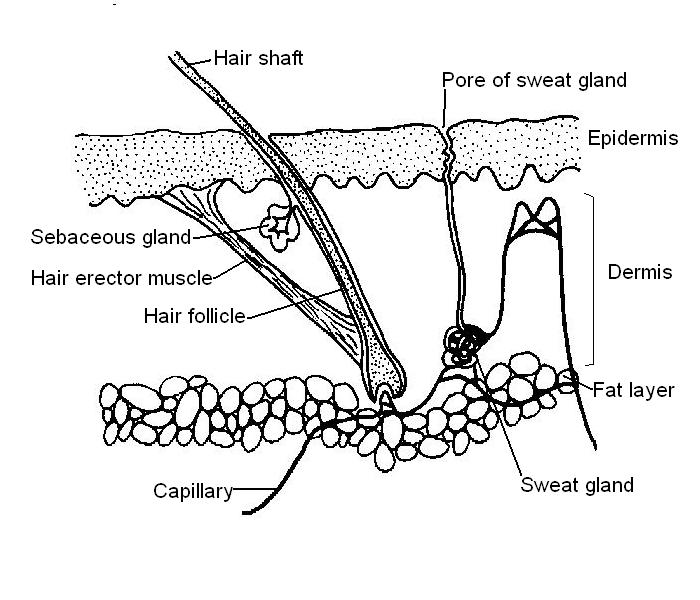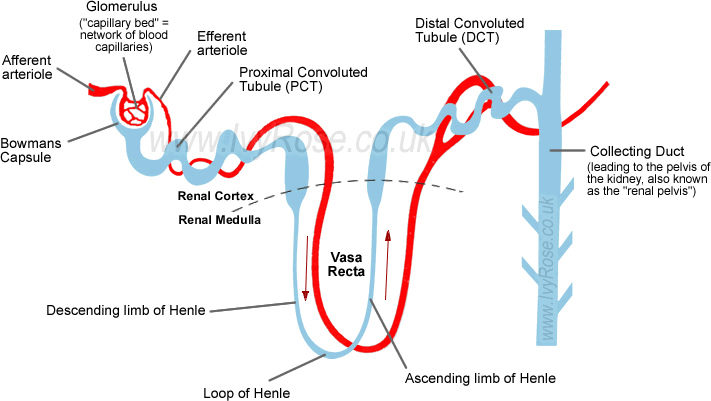Homeostatic Mechanisms
Organisms are able to respond to changes in their environment by adapting their internal body conditions. Homeostasis is the maintenance of a constant internal condition. Examples of homeostasis are osmoregulation, thermoregulation and the regulation of the composition of the blood.
Skin:
Functions:
- Protection
- Waterproof barrier
- Thermoregulation
Thermoregulation:
- Sweat glands release sweat when the internal temperature is too high. The evaporation of sweat uses heat energy of the skin. This takes away heat energy.
- Vasodilation occurs when the body is too warm. The shunt vessel constricts and the capillaries widen meaning more blood flows through the surface of the skin and so more heat is lost through the radiation of heat. Vasoconstriction occurs when you are too cold. The opposite occurs meaning less heat is lost through radiation.
- Hair erector muscles relax to flatten the hair when it is warm. This means less trapped air is present and therefore, there is less insulation. The opposite occurs when it is cold.
- Adrenaline is used to raise metabolism meaning more energy is released and so more heat is also released.
- Shivering - more respiration occurs in muscles meaning more heat is released.
Excretion: the removal of metabolic waste created in cells such as urea, carbon dioxide and water. The lungs, kidneys and skin are all organs of excretion.
Renal/Urinary system:
Function:
The urinary system is used to create, store and remove urine which in turn removes wastes such as urea. Blood flows to the kidneys which separates it into the components of urine: water, urea, some salts. The urine then moves down the ureters and is stored in the bladder until the two sphincter muscles relax where it then exits the body.
The components and various concentrations of urine may vary depending on the amount of water and salt intake and whether you have kidney failure or diabetes.
Kidneys: the kidney is involved in both excretion and osmoregulation.
Nephron: there are millions of these in each kidney and they are the main areas of the kidney where filtration occurs.
Ultrafiltration is the separation of smaller molecules such as glucose, water, urea, oxygen, salts, and amino acids from the blood at the glomerulus in high pressure.
Selective reabsorption is where molecules in the glomerular substrate are retaken by the capillaries at the proximal convoluted tubule. It is selective as only some molecules such as glucose, amino acids and some salts are retaken.
Water is reabsorbed into the blood both through selective reabsorption and through osmosis at the collecting ducts. The latter is controlled by ADH (anti-diuretic hormone). When the hypothalamus detects the blood is too concentrated, it tells the pituitary gland to release ADH which travels via the bloodstream to the kidneys. ADH makes the collecting ducts more permeable to water meaning more water is absorbed. This is how the kidneys act in osmoregulation.
Transplant:
If the kidneys were to fail, without a kidney transplant or dialysis you would die very quickly as the blood will become full of urea, which is toxic. Dialysis is where a machine is used to artificially create a kidney as it essentially performs the job of the kidneys.
Problems:
- Risk of surgery
- Difficulty in finding donors and tissue matching.
- Use of immunosuppressants means the chance of infection is high.
- Chance of organ rejection.
Advantages:
- Relatively cheaper than dialysis.
- Dialysis takes a long time (around thirty hours a week).
- Dialysis may cause damage to arteries and veins.
- Dialysis has a high chance of infection.
- A transplant is a permanent solution.
- A transplant will mean that urea concentration will remain constant while under dialysis it will spike up and down.
Oral rehydration method: this is one of the medications used to prevent dehydration. It is water containing several salts and glucose.
It is vitally important to rehydrate after vomiting or diarrhoea. This is because if you are dehydrated then there is less water to transport vitamins, minerals and glucose and also less water to remove metabolic waste such as carbon dioxide. It is also needed for cell turgidity. As a result, the oral rehydration method is often used following vomiting or diarrhoea.
Liver:
Functions:
- Produces bile which is used to emulsify fats and to neutralise foods in the duodenum to allow enzymes to work at optimum pH.
- Regulates blood sugar. When glucose levels are too high the liver converts glucose to glycogen while the opposite occurs if glucose levels are low
- It controls amino acids concentration. Urea is a byproduct of the breakdown of amino acids.
- The above is an example of detoxification where the liver breaks down toxic substances into less toxic ones. Alcohol is another example of this.
Effects of alcohol:
On liver:
- It causes fat deposits to develop in the liver as metabolism of alcohol needs oxygen, this means more respiration.
- After continued excessive drinking the liver may become inflamed causing alcoholic hepatitis which can result in liver failure and death.
- Excessive alcohol can permanently scar and damage the liver, resulting in liver cirrhosis and an increased risk of liver cancer.
On the nervous system:
- Cells of the central nervous system are affected by alcohol.
- After excessive alcohol, a syndrome called blackout may occur where a person may appear to be functioning in an alert state while not recalling the events afterwards.
- Impaired reaction times and motor co-ordination as vision and hearing are affected.
- Neuropathy where there are alternating feelings of pain, burns, numbness and weakness in hands and feet.
On your behaviour:
- People have less control over their actions as less oxygen is supplied to their brains. The person is, therefore, more likely to commit crimes or does things that they wouldn't normally do or would be irresponsible.




this really helped me!!
ReplyDeletethanks!